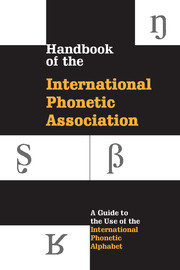 Handbook of the International Phonetic Association
Handbook of the International Phonetic Association Appendix 2 - Computer coding of IPA symbols
Published online by Cambridge University Press: 06 November 2023
Summary
This section is a revision of an article which first appeared in the Journal of the International Phonetic Association 23, 83–97 (1993), entitled ‘Computer codes for phonetic symbols’, by John H. Esling and Harry Gaylord. The chart of IPA Numbers and the coding tables in this section have been updated to 1998.
The process of assigning computer codes to phonetic symbols began when the 1989 Kiel Convention of the International Phonetic Association was called to revise the Association’s alphabet. The Workgroup on Computer Coding formed at that time had the task of determining how to represent the IPA alphabet numerically, and of developing a set of numbers referring to IPA symbols unambiguously. This involved assembling phoneticians who work with computer representations of phonetic symbols, and communicating with specialists in computer coding to gauge the fit between the phonetician’s perspective on symbol usage and the non-phonetician’s understanding of how to identify and use phonetic symbols. Prior to the Kiel meeting, a collection of practical approaches to coded representations was outlined in JIPA (Esling 1988), which dealt mainly with keyboard assignments of characters.
At Kiel, after reviewing several submissions on current practice, the Workgroup concluded that each symbol used by the IPA should be assigned a unique, three-digit number known as its IPA Number. IPA Numbers were assigned in linear order following the new IPA Chart which resulted from the deliberations at Kiel (IPA 1989a). IPA Numbers were not only created for approved consonant, vowel, diacritic and suprasegmental symbols, but also for symbols often referred to in IPA deliberations or implied by IPA convention but which do not appear explicitly on the IPA Chart.
The conclusions and recommendations reached by the Workgroup at Kiel appeared in JIPA (IPA 1989b), followed by a supplementary report with an initial listing of IPA Numbers by symbol and by symbol name (Esling 1990). The comprehensive documentation of phonetic symbol usage and categorization in the Phonetic Symbol Guide by Pullum and Ladusaw (1986, 1996) assisted in this process. Several recommendations were made at Kiel, including the use of at least two levels of transcription when entering coded phonetic values to accompany data, but what is most important to point out about the process of associating each possible character with a discrete numerical entity is its comprehensive nature. No symbols could be ignored, and the application of diacritics had to be made explicit.
- Type
- Chapter
- Information
- Handbook of the International Phonetic AssociationA Guide to the Use of the International Phonetic Alphabet, pp. 161 - 185Publisher: Cambridge University PressPrint publication year: 1999
